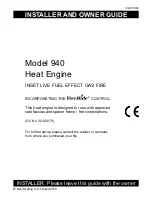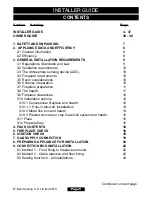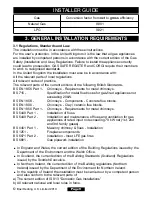
3.10.3
Precast concrete or clay flue block system and hearth.
To a precast concrete or clay flue
block system conforming to BS1289
with dimensions as in figure 6. The
current versions of BS1289 and BS
EN 1858 recommend that there
should be an air space or insulation
between the flue blocks and the
plaster because heat transfer may
cause cracking on directly plastered
flues. However, generally this
appliance is suitable for installations
under all circumstances unless there
is a history of cracking problems.
Remember that faults such as
cracking may be caused by poorly
built and restrictive flues, e.g. mortar
extrusions, too many bends, flue
heights below three metres, restrictive
terminations etc.
3.11 Flues.
1.
Suitable flues and minimum flue
sizes are as follows: -
It should be noted that, as with many
appliances, sharp bends or horizontal
runs in metal flues at the top of the
system can be a cause of problems in
these types of installation.
225mm x 225mm conventional
brick flue.
175mm diameter lined brick or stone flue.
200mm diameter factory made insulated flue manufactured to BS4543.
175mm diameter flue pipe. See BS6461 Part 1 for suitable materials.
Single wall, twin wall or flexible flue liner with a minimum diameter of 125mm. The
materials to be used are stainless steel or aluminium as specified in
BS EN 1856 Part 1. The liner must be sealed to the surrounding area above the
fireplace opening and to the top of the chimney. An approved terminal must be fitted.
A properly constructed precast concrete or clay flue system conforming to BS1289
or BS EN 1858. This system is only suitable if the conditions stated in section 3.10.3
are met.
2.
The flue must conform to BS 5440: Part 1 in design and installation.
The flue, measured from the bottom of the fireplace opening to the bottom of the
Page 15
©
Baxi Heating U.K. Limited 2010.
Figure 6. Precast or clay flue block system
INSTALLER GUIDE
















































